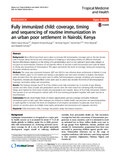Fully immunized child: coverage, timing and sequencing of routine immunization in an urban poor settlement in Nairobi, Kenya

View/
Date
2016-05Author
Mutua, M. K.
Murage, E. K.
Ngomi, Nicholas N.
Mwaniki, P.
Echoka, E.
Metadata
Show full item recordAbstract
Background: More efforts have been put in place to increase full immunization coverage rates in the last decade. Little is known about the levels and consequences of delaying or vaccinating children in different schedules.Vaccine effectiveness depends on the timing of its administration, and it is not optimal if given early, delayed or not given as recommended. Evidence of non-specific effects of vaccines is well documented and could be linked to timing and sequencing of immunization. This paper documents the levels of coverage, timing and sequencing
of routine childhood vaccines.
Methods: The study was conducted between 2007 and 2014 in two informal urban settlements in Nairobi. A total of 3856 children, aged 12–23 months and having a vaccination card seen were included in analysis. Vaccination dates recorded from the cards seen were used to define full immunization coverage, timeliness and sequencing.
Proportions, medians and Kaplan-Meier curves were used to assess and describe the levels of full immunization coverage, vaccination delays and sequencing.
Results: The findings indicate that 67 % of the children were fully immunized by 12 months of age. Missing measles and third doses of polio and pentavalent vaccine were the main reason for not being fully immunized. Delays were highest for third doses of polio and pentavalent and measles. About 22 % of fully immunized children had vaccines in an out-of-sequence manner with 18 % not receiving pentavalent together with polio vaccine as recommended.
Conclusions: Results show higher levels of missed opportunities and low coverage of routine childhood vaccinations given at later ages. New strategies are needed to enable health care providers and parents/guardians to work together to increase the levels of completion of all required vaccinations. In particular, more focus is needed on vaccines given in multiple doses (polio, pentavalent and pneumococcal conjugate vaccines).
URI
https://www.ncbi.nlm.nih.gov/pmc/articles/PMC4940963/https://pubmed.ncbi.nlm.nih.gov/27433132/
https://www.researchgate.net/publication/303457321_Fully_immunized_child_Coverage_timing_and_sequencing_of_routine_immunization_in_an_urban_poor_settlement_in_Nairobi_Kenya
https://tropmedhealth.biomedcentral.com/articles/10.1186/s41182-016-0013-x/figures/2
https://go.gale.com/ps/anonymous?id=GALE%7CA603078441&sid=googleScholar&v=2.1&it=r&linkaccess=fulltext&issn=13494147&p=AONE&sw=w
http://hdl.handle.net/123456789/4544
Collections
- Journal Articles (PAS) [285]
